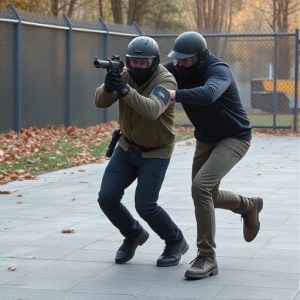Unveiling Stun Gun Science: Current Spread Analysis for Optimal Effectiveness
Understanding how electrical current spreads is crucial for developing police-grade stun gun options…….
Understanding how electrical current spreads is crucial for developing police-grade stun gun options. Manufacturers consider factors like material conductivity, geometry, and voltage to control current flow precisely. By optimizing electrode placement, voltage output, and pulse duration based on current spread patterns, these stun guns achieve powerful results while minimizing risk. Police-grade stun gun options like Tasers have transformed law enforcement globally due to their safe and swift neutralization capabilities. Proper knowledge of electrical current spread ensures maximum effectiveness with minimal harm to officers and civilians, enhancing officer safety and crowd control tactics.
“Electrical current spread patterns are crucial in understanding the impact and effectiveness of stun guns, particularly in police grade options. This article delves into the fundamental concept of how electrical current flows and its implications for stun gun design. We explore the science behind these devices, analyzing their unique features and how they influence current distribution. Furthermore, we discuss practical applications, highlighting the significance of spread pattern assessment in various real-world scenarios, offering insights into the best police grade stun gun options available.”
- Understanding Electrical Current Spread: A Fundamental Concept
- Police Grade Stun Guns: Unlocking the Science Behind Their Effectiveness
- Analyzing Stun Gun Design and Its Impact on Current Distribution
- Practical Applications: Real-World Scenarios for Spread Pattern Assessment
Understanding Electrical Current Spread: A Fundamental Concept

Understanding how electrical current spreads is a fundamental concept in electronics and has significant implications, especially when considering police-grade stun gun options. When an electric charge is applied to a conductive material, it seeks the path of least resistance to flow from the source to the ground. This phenomenon is what enables us to harness and control electricity for various applications, including stun guns. The spread of current depends on factors such as the material’s conductivity, its geometry, and the voltage applied.
In the context of stun guns, knowing how electric current spreads helps in designing devices that deliver the right amount of force and safety. Police-grade stun guns are engineered to create a high-voltage, low-current electrical pulse, ensuring a powerful yet controlled effect on the target. By understanding the current spread pattern, manufacturers can optimize the placement of electrodes, voltage output, and pulse duration, making these devices more effective and safer for both officers and individuals in need of protection.
Police Grade Stun Guns: Unlocking the Science Behind Their Effectiveness

Police-grade stun guns, also known as Tasers, have become a staple in law enforcement worldwide due to their effectiveness in neutralizing dangerous situations swiftly and safely. The technology behind these devices involves delivering electrical impulses that disrupt the nerve signals between the brain and muscles, temporarily incapacitating the target. This method ensures minimal physical harm compared to traditional force, making it a game-changer for police tactics.
When selecting a stun gun, officers have various options tailored to different needs. High voltage models are ideal for close-range encounters, while lower settings offer more versatility for distant or subtle interventions. Advanced features like digital display for charge level and pulse modes enhance operator control. Understanding the spread pattern of electrical current is crucial; it determines the optimal distance for deployment, ensuring maximum impact and minimal risk to both officers and citizens.
Analyzing Stun Gun Design and Its Impact on Current Distribution

The design of a stun gun plays a significant role in understanding and analyzing the spread pattern of electrical current. In the context of Police Grade Stun Gun Options, manufacturers often consider factors like current density, discharge pattern, and energy distribution to optimize their devices for maximum effectiveness while minimizing off-target effects. Advanced models incorporate sophisticated circuitry and unique shapes to control and direct the electric current, ensuring it reaches the intended target with precision.
By examining how different stun gun designs impact current distribution, researchers can gain insights into performance improvements. For instance, some models feature optimized contact points or specialized electrodes that facilitate more uniform current flow, enhancing stun effectiveness while potentially reducing the risk of collateral damage. This analysis is crucial in law enforcement and self-defense applications, where the ability to control and manipulate current spread directly influences the safety and success of an intervention.
Practical Applications: Real-World Scenarios for Spread Pattern Assessment

In practical terms, understanding electrical current spread patterns has profound implications for various real-world scenarios, especially in fields like security and law enforcement. One notable application is in evaluating the effectiveness of police-grade stun guns. By analyzing how electric current spreads across the human body upon impact, manufacturers and researchers can optimize the design of these devices to ensure maximum stun capacity while minimizing off-target effects. This assessment is crucial for developing safer and more reliable stun gun options for law enforcement agencies.
Moreover, this knowledge aids in the development of safety protocols and training programs. For instance, understanding current spread patterns helps officers learn how to position themselves and their devices optimally during a confrontation, minimizing the risk of accidental shocks or bystander harm. This strategic approach not only enhances officer safety but also contributes to more effective crowd control tactics.
Electrical current spread pattern analysis is a critical aspect of understanding the effectiveness and safety of police grade stun guns. By delving into the fundamental concepts, exploring the science behind their operation, analyzing design impacts on current distribution, and assessing real-world applications, we’ve uncovered valuable insights. This knowledge not only enhances our comprehension of stun gun technology but also guides the development of improved Police Grade Stun Gun options. Optimizing current spread patterns can lead to more efficient and safer non-lethal force tools, ensuring public safety without causing excessive harm.


